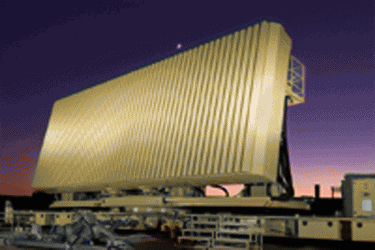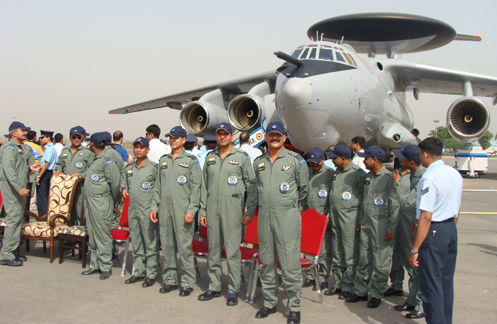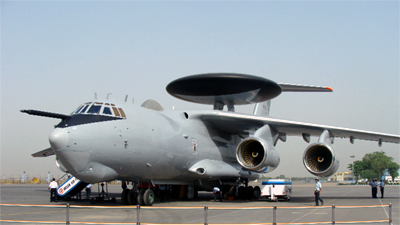Chanakyaa
BANNED

- Joined
- Jan 17, 2009
- Messages
- 6,538
- Reaction score
- -36
- Country
- Location
[ 'Feel India' Series - Article 5 ]
A List of Radars Employed By the Indian Armed Forces :
1. Rohini Radar
2. Rajendra Radar

3. The Indra Radar

4. Aerostat Radar
5. GreenPine Radar

6. Sword Fish Radar

7. Indian Army : Weapon Locating Radars

8. GS 100
A List of All Radars :
A List of Radars Employed By the Indian Armed Forces :
1. Rohini Radar
The Central Acquisition Radar (3D-CAR) is a 3D radar developed by DRDO for use with Akash SAM. The 3D CAR was developed as part of a program between DRDO and Poland's PIT to develop a family of mobile, S-Band 3D radars.
The areas of cooperation were in developing the Planar Array and general architecture. The Indian variant is the 3D CAR, a medium range surveillance radar for Akash at Group level, intended to provide high mobility and comprehensive high and low level coverage. The Polish versions, are the TRS series of S Band mobile radars such as the TRS-17 and TRS-19. The original Indian (3D CAR) and Polish (TRS 17) radars shared the basic architecture and antenna but differed in terms of purpose designed transmitter/receivers, and signal processing equipment. The TRS series for instance can track 120 targets, while the Indian radar tracks 150.
2. Rajendra Radar

The Rajendra Multi-Function Phased Array radar system, designed at the Electronics and Radar Development Establishment (LRDE), part of DRDO, is currently in production at Bharat Electronics Limited. This is named after India's First president Dr. Rajendra Prasad.
The LRDE is working on the Rajendra III radar for the Indian Army.[1] Rajendra III is a slewable phased array radar based on the T-72 chassis. As of 2007, the BLR-III vehicle on T-72 chasis was ready for a track test. The Phased array antenna is fabricated at Bharat Electronics Limited (BEL), Ghaziabad. Collimated beam pattern and s/s cure for all 16 spot frequencies has been taken.
Current orders for the Rajendra and its derivatives are at least 32 units, considering the order for 2 Squadrons of the Akash system by the Indian Air force and the indent for 28 Weapon Locating Radars by the Indian Army.
3. The Indra Radar

The Indian Doppler Radar (INDRA) series of 2D radars were developed by India's DRDO for the Army and Air Force. The INDRA-I is a is a mobile surveillance radar for low level target detection while the INDRA-II is for ground controlled interception of targets.
INDRA-I is a 2D mobile surveillance radar for low level target detection. The radar is housed in two wheeled vehicles. Some of the main features are automated Track While Scan (TWS), integrated IFF and high scan rate for high speed target detection. The radar is produced by Bharat Electronics Limited and inducted into service. The INDRA-I was a landmark project for the DRDO, as it was the first large radar system designed by the organization and produced in number for the defence forces. The Indian Air Force operates thirty INDRA-I's whereas the Indian Army also has several.
INDRA-II
It is a variant of INDRA radar for ground controlled interception of targets. The radar uses pulse compression for detection of low flying aircraft in heavy ground clutter with high range resolution and ECCM capabilities. The radar has been produced by Bharat Electronics Limited and is used by Indian Air Force and Army. Seven INDRA-IIs have been ordered by the Indian Air Force.
4. Aerostat Radar
India has recently acquired Aerostat radars. The entire system is divided in major parts. Firstly, the aerostat balloon which has been acquired from Israel and second part is the payload on board the balloon which consists, advanced programmable radar (APR), Electronic Intelligence (ELINT), Communication Intelligence (COMINT) and V/UHF radio telephony equipment and Identification Friend or Foe (IFF). It has the capability to be integrated with AWACS and ground air defence environment and funtion as a command and control centre. Depending upon the payload the theethered balloon can be raised to the height between 10000 feet to 16000 feet.
The system gives a seamless radar cover of 300 km plus at low level along with good RT range and requisite ELINT. The system could be termed as static AWACS. Off course it comes with some vulnerabilities and limitations, like weather, wind speeds, lightning & thunder, launch & recovery periods are vulnerabilities. Its virtues also make it a prime target for enemy therfore it needs to be protected by exclusive air defence weapons. But we hope that the advantages of such system would outlast the limitations
5. GreenPine Radar

India has recently acquired Aerostat radars. The entire system is divided in major parts. Firstly, the aerostat balloon which has been acquired from Israel and second part is the payload on board the balloon which consists, advanced programmable radar (APR), Electronic Intelligence (ELINT), Communication Intelligence (COMINT) and V/UHF radio telephony equipment and Identification Friend or Foe (IFF). It has the capability to be integrated with AWACS and ground air defence environment and funtion as a command and control centre. Depending upon the payload the theethered balloon can be raised to the height between 10000 feet to 16000 feet. The system gives a seamless radar cover of 300 km plus at low level along with good RT range and requisite ELINT. The system could be termed as static AWACS. Off course it comes with some vulnerabilities and limitations, like weather, wind speeds, lightning & thunder, launch & recovery periods are vulnerabilities. Its virtues also make it a prime target for enemy therfore it needs to be protected by exclusive air defence weapons. But we hope that the advantages of such system would outlast the limitations
India had acquired and deployed two Green Pine radars around July 2002 and another one in August 2005.[33] The Swordfish Long Range Tracking Radar of the Indian Defence Research and Development Organisation is an acknowledged derivative of the original Green Pine.[34]
The Indian government has sought to purchase the complete Arrow system since 1999,[3] but in early 2002 the U.S. vetoed Israel's request to sell the Arrow 2 missiles to India,[4][33] exercising its right as a major funding contributor.[35] U.S. officials argued that the sale would violate the Missile Technology Control Regime (MTCR).[
6. Sword Fish Radar

Swordfish is an Indian Long range tracking radar specifically developed to counter ballistic missile threat. It will be a part of India's ballistic missile program. First testing of this radar was in March 2009. Main aim of the test was to validate the capabilities of the indigenously developed Swordfish Long Range Tracking Radar (LRTR). "The missile to be hit will be fired from a longer distance than it was in the earlier test. DRDO tested whether the radar could track the incoming missile from that distance or not" said a member of the project.
Swordfish is an acknowledged derivative of the Israeli Green Pine long range radar, which is the critical component of that country's Arrow missile defence system. [1] However, it differs from the Israeli system as it employs Indian Transmit Receive modules, signal processing, computers and power supplies. It is also more powerful than the base Green Pine system and was developed to meet India's specific BMD needs.
7. Indian Army : Weapon Locating Radars

The BEL Weapon Locating Radar (WLR) is a mobile artillery locating Phased array radar developed by India. This counter-battery radar is designed to detect and track incoming artillery and rocket fire to determine the point of origin for Counter-battery fire.
The WLR has been jointly developed by DRDO's Bangalore based laboratory, LRDE and the Government owned Bharat Electronics Limited (BEL). The sub-systems have been fabricated by BEL based on the DRDO designs and delivered to LRDE for integration.[3]
8. GS 100
French defense avionics company Thales and Bharat Electronics Ltd (BEL) have announced a deal for supply of 19 Ground Smarter GS-100 low level portable radars to the Indian Air Force.
India initiated procurement of low level radar systems for the IAF in 2003.
Finalization of the contract was announced during the 2009 Dubai Air Show.
"This contract reinforces our position in the Indian region as a major supplier of air defense radars," said Richard Deakin, Thales senior vice president and head of the air systems division. "BEL is a leading supplier of defense electronics systems and subsystems and plays a leading role in a number of major Indian defense programs."
Under the TOT deal, Thales will build the initial six radars at its Limours facility, southwest of Paris. BEL will build the remaining 13 radars in India.
Details of the project and GS-100 capabilities are listed at my knol Thales Ground Smarter GS-100 radars for IAF.
A List of All Radars :
3. India
3. 1. Military
3. 1. 1. Naval
* Super Vision-2000 3D airborne naval surveillance radar.
* Revathi 3D Naval Medium range radar derived from the 3D CAR
3. 1. 2. Land-based and airborne
* INDRA series of 2D radars, low level radar to search and track low flying cruise missiles, helicopters and aircraft for the Indian Army and the Indian Air Force.
* BFSR-SR 2D short range battlefield surveillance radar for the Indian Army.
* Rajendra Radar 3D medium range fire control radar for Akash SAM.
* Central Acquisition Radar (3D-CAR) planar array tracking radar for all branches of the Indian armed forces. Air force version known as the Rohini. Naval version known as Revathi.
* 3D AESA Long Range Tracking Radar tracking high speed ballistic missile targets.
* Low Level Lightweight Radar(LLLR) 2D low level aircraft tracking radar.
3. 2. Under development
* Weapon Locating Radar 3D passive electronically scanned array to detect multiple targets for fire correction and weapon location for Akash SAM, developed from Rajendra.
* HAL Multi-mode radar 3D advanced, lightweight multimode fire control radar for LCA Tejas.
* Airborne Warning and Control 3D Active Electronically Scanned Array
* Short Range Radar 3D tracking small fighter sized targets.
* BFSR-MR 2D medium range battlefield surveillance for the army. Probably has been replaced by long range battlefield surveillance radar.
* MFCR 3D active phased array radar, complements the Long Range Tracking Radar, for intercepting Ballistic Missiles.
* MEDIUM POWER RADAR 3D ACTIVE PHASED ARRAY RADAR, being developed for indian air force for the ranges more than 300km.
Last edited:

















